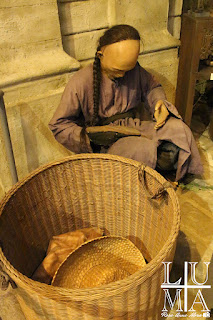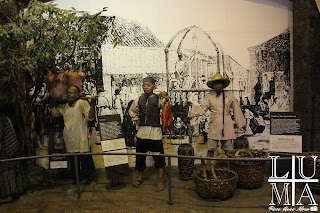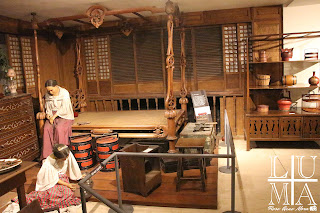Business will always be in their blood.
Bahay Tsinoy (Chinese-Filipino House) is a museum located inside Intramuros, Manila. Housed in Kaisa-Angelo King Heritage Center building, the museum documents the lives and contributions of the Chinese in the Philippines.
The museum is unique for their life-sized exhibits and some are even modeled from rare prints and photographs.
 |
| Kaisa-Angelo King Heritage Center's facade. |
This three-floor building is fully air-conditioned and was designed by Arch. Rogelio G. Villarosa with an American Colonial Architectural style. The museum is divided into different sections that introduces us to the role that the Chinese played from pre-colonial period up to the present time. The museum opened in 1999 and has been active since then.
 |
| Museum's spacious lobby. |
 |
| Entrance to the museum proper. |
Sangley is a term used in the Philippines during the Spanish era to describe a person of pure Chinese ancestry.
Mestizo de Sangley refers to a person of mixed Chinese and Filipino ancestry.
Tsinoy (from the Spanish word Chino, and the word Pinoy) is also used to refer to a person of Chinese and is wildly used today.
Early Contacts
The Chinese entered the Philippines as traders for years prior to
Spanish colonization. With the increased in business
opportunities and work, many emigrated to the Philippines. They established
concentrated communities first in Manila, then in other cities.
 |
| The Galleon Trade |
 |
| Ancient Coins |
These coins said to be circulated between 7th and 14th century. These specimens were found in Cebu, Leyte, and Bohol.
The Parian
The Parian which is located in Intramuros as well was built by the Spaniards to house Chinese merchants in 16th and 17th century. In 1583, it was burned down and the Chinese community later moved to Binondo, Sta. Cruz and Tondo.
 |
| A diorama depicting the 1583 destruction of Parian. |
Colonial Culture
These life-sized exhibits are based on real photographs depicting the occupations of early Chinese - merchants, laborers and artisans.
A Public Reader in Manila.
For a fee, he reads and writes letters for illiterate Chinese.
A Chinese Cobbler.
His kit is in baskets supported by a stick across his shoulders. Shoes can be fixed in the streets, or anywhere convenient.
A Chinese goldsmith at work.
Facade of San Agustine Church.
A Chinese peddler selling food.
A Chinese Textile Merchant.
Carpenters.
Many churches, monasteries, hospitals and stone houses were built by Chinese laborers.
A wealthy Chinese merchant.
 |
| Tombstones recovered from Sta. Ana Church. |
Life and Economy in the 1800s
 |
| Example of a typical sari-sari store owned by Chinese. |
Typical Mestizo House during 1800s.
Gallery of Rare Prints and Photographs
Chinese in the Philippines have a really rich history that can be traced back in the 16th century and it is evident in Chinese-Filipino communities here in the Philippines. The enthusiasm, the hard work, and the love for businesses to survive without depending to anyone in their family are good traits that we can take as an inspiration in our lives today.
Bahay Tsinoy Museum
32 Anda Cor. Cabido St.
Intramuros, Manila
open Tuesdays to Sunday, 1pm to 5pm
Entrace fee is P100 each (P60 for students)
Sources:
http://www.bahaytsinoy.org/
https://en.wikipedia.org/wiki/Bahay_Tsinoy










































